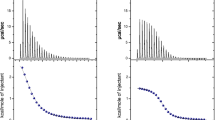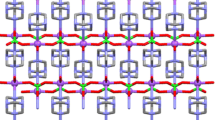Abstract
The behavior of potassium tetrachloropalladate(II) in media simulating biological liquids is studied. The rate of aquation in aqueous NaCl solutions is shown to be higher than the rate at which the Cl− ligand enters the inner coordination sphere of the Pd atom. In HCl solutions, the formation of the Pd chloro complexes predominates due to protonation of water molecules in the composition of aqua complexes. The reactions of replacement of the ligands (H2O molecules and H3O+ ion) in the planar Pd(II) complexes by the chloride ion are studied by the ZINDO/1 method. All the complexes containing H2O and H3O+ ligands, except for [Pd(H2O)4]2+, contain intramolecular hydrogen bonds. The ZINDO/1 and RHF/STO-6G(d) calculations revealed “nonclassic” symmetrical O⋯ H⋯O hydrogen bond in the [[Pd(H2O)3(H3O)]3+ and trans-[Pd(H2O)2(H3O)Cl]2+ complexes. The replacement of the H3O+ ion by the Cl− ion at the first three steps is thermodynamically more advantageous than the displacement of water molecules from the metal coordination sphere. The logarithms of stepwise stability constants of Pd(II) chloro complexes are found to correlate linearly with the enthalpies (ZINDO/1, PM3) of reactions of H2O replacement by Cl−.
Similar content being viewed by others
REFERENCES
Zakharova, I.A., Issledovaniya po neorganicheskoi khimii i khimicheskoi tekhnologii (Investigations into Inorganic Chemistry and Chemical Technology), A.Yu, Tsivadze, Ed., Moscow: Nauka, 1988.
Stetsenko, A.I., Yakovlev, K.I., and D'yachenko, S.A., Usp. Khim., 1981, vol. 56, no.9, p. 1543.
Todorov, I., Klinicheskie laboratornye issledovaniya v pediatrii (Clinical Laboratory Trials in Pediatry), Sofia: Meditsina i Fizkul'tura, 1968.
Sintez kompleksnykh soedinenii metallov platinovoi gruppy: Spravochnik (Synthesis of Platinum Group Metal Complexes. A Handbook), Chernyaev, I.I., Ed., Moscow: Nauka, 1964, p. 173.
Forber, Ch.L., Kelusky, E.C., Bunce, N.J., and Zerner, M.C., J. Am. Chem. Soc., 1985, vol. 107, no.21, p. 5884.
Stewart, J.J.P., J. Comput. Chem., 1989, vol. 10, no.2, p. 209.
Clark, T., A Handbook of Computational Chemistry, New York: Wiley, 1985.
Dennis, J., Jr. and Schnabel, R., Numerical Methods for Unconstrained Optimization and Nonlinear Equations, Englewood Cliffs: Prentice-Hall, 1983.
Ito, H., Fujita, J., and Saito, K., Bull Chem. Soc. Jpn., 1967, vol. 40, no.11, p. 2584.
Elding, L.I., Inorg. Chim. Acta, 1972, vol. 6, no.4, p. 647.
Kukushkin, Yu.N. and Bobokhodzhaev, R.I., Zakonomernost' transvliyaniya Chernyaeva (Regularities of Chernyaev Trans-Effect), R.N, Shchelokov, Ed., Moscow: Nauka, 1977.
Kukushkin, Yu.N., Khimiya koordinatsionnykh soedinenii (The Chemistry of Coordination Compounds), Moscow: Vysshaya Shkola, 1985.
Zefirov, Yu.V., Zh. Obshch. Khim., 1976, vol. 46, no.11, p. 2636.
Zefirov, Yu.V. and Zorkii, P.M., Zh. Strukt. Khim., 1976, vol. 17, no.6, p. 994.
Zefirov, Yu.V. and Zorkii, P.M., Usp. Khim., 1989, vol. 58, no.5, p. 713.
Zefirov, Yu.V. and Zorkii, P.M., Problemy kristallokhimii 1992, no. 9, Porai-Koshits, M.A., Ed., Moscow: Nauka, 1993, p. 6.
Zorkii, P.M., Problemy kristallokhimii 1992, no. 9, Porai-Koshits, M.A., Ed., Moscow: Nauka, 1993, p. 188.
Zefirov, Yu.V. and Zorkii, P.M., Usp. Khim., 1995, vol. 64, no.5, p. 446.
Bulychev, V.P. and Sokolov, N.D., Vodorodnaya svyaz' (Hydrogen Bond), Sokolov, N.D, Ed., Moscow: Nauka, 1981, p. 10.
Dneprovskii, A.S. and Temnikova, T.I., Teoreticheskie osnovy organicheskoi khimii (Theoretical Bases of Organic Chemistry), Leningrad: Khimiya, 1991.
Sokolov, N.D., Vodorodnaya svyaz' (Hydrogen Bond), Sokolov, N.D, Ed., Moscow: Nauka, 1981, p. 63.
Giricheva, N.I., Girichev, G.V., Lapshina, S.B., and Kuz'mina, N.P., Zh. Strukt. Khim., 2000, vol. 41, no.1, p. 58.
Giricheva, N.I., Doctoral (Chem.) Dissertation, Ivanovo: Inst. of Solution Chemistry, 2000.
Knorre, D.G., Krylova, L.F., and Muzykantov, V.S., Fizicheskaya khimiya (Physical Chemistry), Moscow: Khimiya, 1990.
Dewar, M.J.S., The Molecular Orbital Theory of Organic Chemistry, New York: McGraw-Hill, 1969.
Pankratov, A.N. and Shchavlev, A.E., Can. J. Chem., 1999, vol. 77, no.12, p. 2053.
Pankratov, A.N., J. Mol. Struct.: THEOCHEM, 2000, vol. 507, nos.1–3, p. 239.
Pankratov, A.N., Helv. Chim. Acta, 2004, vol. 87, no.6, p. 1561.
Pankratov, A.N. and Uchaeva, I.M., Zh. Neorg. Khim., 2004, vol. 49, no.9, p. 1520 [Russ. J. Inorg. Chem. (Engl. Transl.), vol. 49, no. 9, p. 1403].
Pankratov, A.N. and Shalabay, A.V., Zh. Strukt. Khim., 2004, vol. 45, no.5, p. 800.
Pankratov, A.N., Zh. Anal. Khim., 2005, vol. 60, no.2, p. 149 [J. Anal. Chem. (Engl. Transl.), vol. 60, no. 2, p. 130].
Pankratov, A.N., Khim. Geterotsikl. Soedin., 2005, no. 3, p. 391.
Surova, T.V. and Enyashin, A.N., Zh. Strukt. Khim., 2003, vol. 44, no.2, p. 334.
Shchukarev, S.A., Lobaneva, O.A., Ivanova, M.A., and Kononova, M.A., Vestn. Leningrad. Gos. Univ., Ser. Fiziki i Khimii, 1961, no. 10, issue2, p. 152.
Biryukov, A.A. and Shlenskaya, V.I., Zh. Neorg. Khim., 1964, vol. 9, no.4, p. 813.
Burger, K. and Dyrssen, D., Acta Chem. Scand., 1963, vol. 17, no.6, p. 1489.
Burger, K., Acta Chim. Acad. Scient. Hung., 1964, vol. 40, sec. 1, p 261.
Burger, K., Magyar Kem. Folyoirat, 1964, vol. 70, no.4, p. 179.
Author information
Authors and Affiliations
Additional information
__________
Translated from Koordinatsionnaya Khimiya, Vol. 31, No. 9, 2005, pp. 696–702.
Original Russian Text Copyright © 2005 by Pankratov, Borodulin, Chaplygina.
Rights and permissions
About this article
Cite this article
Pankratov, A.N., Borodulin, V.B. & Chaplygina, O.A. Ligand Exchange in Pd(II)-NaCl-H2O and Pd(II)-HCl-H2O Systems: Quantum-Chemical Consideration. Russ J Coord Chem 31, 660–666 (2005). https://doi.org/10.1007/s11173-005-0152-9
Received:
Issue Date:
DOI: https://doi.org/10.1007/s11173-005-0152-9




